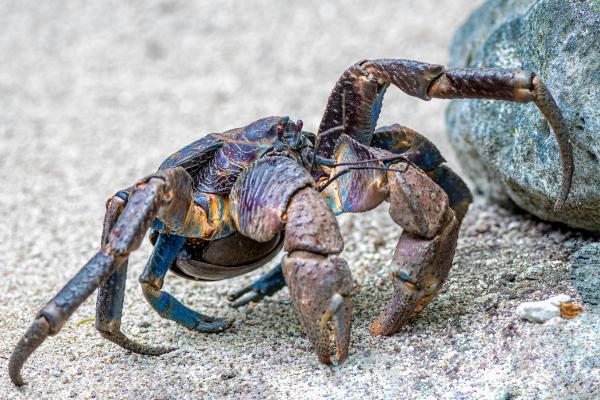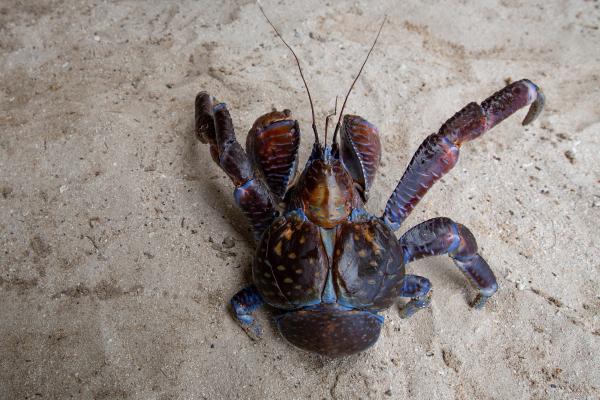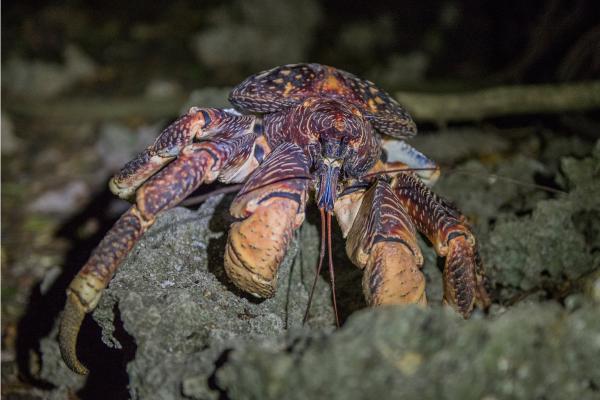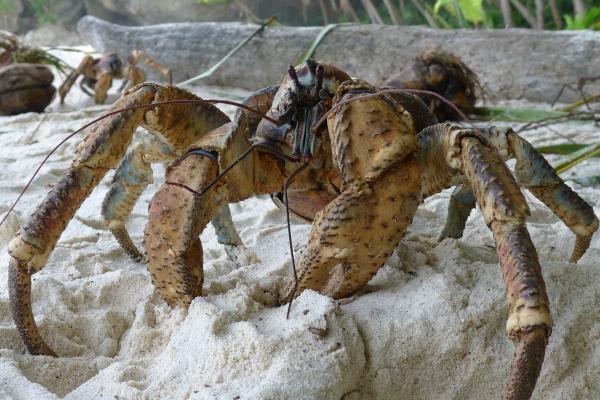The coconut crab (Birgus latro) is a terrestrial crustacean and the heaviest crab species in the world, capable of weighing up to 4 kilograms and reaching nearly one meter in leg span. Famous for its ability to open coconuts, it is also an opportunistic scavenger with a varied diet. Coconut crabs inhabit small islands across the Pacific and Indian Oceans, typically residing in coastal limestone forests. This article explores the unique features, habitat, diet, and reproduction of the remarkable coconut crab.

Largest terrestrial arthropod: Weighs up to 4 kg and spans about one meter from leg to leg.
Eight legs: Four pairs of legs, with the front pair evolved into powerful pincers used for climbing, defense, and food handling. These pincers can lift objects up to 30 kg.
Coconut opener: Uses its strong claws to crack open coconuts, the origin of its common name.
Protective coconut shell: Unlike hermit crabs that use shells, adult coconut crabs use hollowed-out coconut shells to shield their abdomen.
Highly developed sense of smell: Moves its antennae to detect scents from long distances.
Lung-like gills: Breathes air but requires moist environments to keep its gills wet. Cannot survive underwater for extended periods.
Coconut crabs are found on small tropical islands in the Indian and Pacific Oceans, including Zanzibar, the Cook Islands, Mariana Islands, Easter Island, and Seychelles. The larvae are aquatic and disperse via ocean currents to colonize these islands.
Prefer limestone coastal forests, sheltering in rock crevices, burrows, or under opened coconuts.
Require humid environments near water to maintain gill moisture.
Considered a delicacy and traditional aphrodisiac by some local communities, leading to overharvesting and population decline in certain regions such as Madagascar and Australia.
Thrive on uninhabited islands with few predators due to their size and strength.

Active mostly at night, coconut crabs use their acute sense of smell to locate food since their vision is poor.
Primarily feed on coconuts, cracking open both the husk and pulp with their powerful claws.
Opportunistic scavengers that consume:
Decaying wood
Animal carcasses
Molted shells of lobsters
Pandanus plants
Other crabs
Various organic matter
They are important scavengers in their ecosystems, contributing to nutrient cycling.

Internal fertilization occurs when the male transfers a spermatophore to the female’s reproductive tract.
Females carry between 51,000 to 138,000 eggs attached to specialized appendages under the abdomen.
Eggs start at 0.6 mm and grow to about 1 mm, usually laid in summer.
At hatching, females release larvae into seawater where they spend about 8 weeks in a planktonic stage called the glaucothoe.
Larvae seek empty gastropod shells or coconut fragments for protection, eventually metamorphosing into juvenile crabs and later emerging as terrestrial adults.
They grow larger with each molt and can live up to 60 years, exhibiting exceptional longevity among arthropods.

Coconut crabs are fascinating creatures, notable for their size, strength, and unique terrestrial adaptations. Protecting their habitats and regulating harvesting are crucial for preserving this iconic species and maintaining island ecosystem balance.
Bibliografía
Amesbury, S. S. (1980). Biological studies on the coconut crab (Birgus latro) in the Mariana Islands. Agricultural Experiment Station, College of Agriculture and Life Sciences, University of Guam.
animal tags: coconut crab
We created this article in conjunction with AI technology, then made sure it was fact-checked and edited by a Animals Top editor.